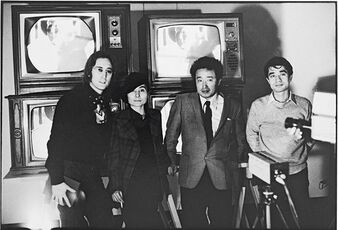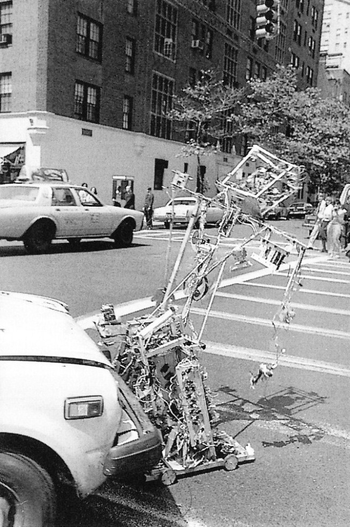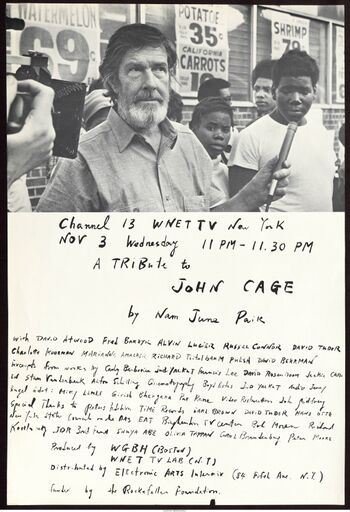Nam June Paik
 John Lennon, Yoko Ono, Nam June Paik and Shuya Abe at the Galeria Bonino, New York, 23 November 1971. Photo: Tom Haar. [1] | |
| Born |
July 20, 1932 Seoul, South Korea |
|---|---|
| Died |
January 29, 2006 (aged 73) Miami, Florida, United States |
| Web | UbuWeb Film, Wikipedia |
| Collections | NJPAC Seoul, Mumok 85, SFMOMA 62, ZKM 60, EAI 42, MoMA 36, Pompidou 31, Whitney 29, NGA 24, Tate 17, Ludwig 13, Walker 10, SAAM 10, Stedelijk 10, Reina Sofia 9, NSW Sydney 9, Moderna Museet 7, NRW 5, MMK Frankfurt 5, NGA Canberra 4, Guggenheim 3, Artic 3, Generali 3, Flick 2, Kunstpalast Düsseldorf 1, VDB 1, Boijmans 1, LACMA 1, IMA 1, VMFA 1, Stuart 1, Daimler 1, Zabludowicz |
Nam June Paik (1932-2006), internationally recognized as founder of video art, created a large body of work, including video sculptures, installations, performances, videotapes and television productions. His art and ideas embodied a radical new vision for an art form that changed global visual culture.
Born in 1932 in Seoul, Korea, to a wealthy industrial family, Paik and his family fled Korea in 1950 at the outset of the Korean War, first to Hong Kong, then to Japan. Paik graduated from the University of Tokyo in 1956, and then traveled to Germany to pursue his interest in avant-garde music, composition and performance. There he met John Cage and George Maciunas and became a member of the Fluxus movement. In 1963, Paik had his legendary one-artist exhibition at the Galerie Parnass in Wuppertal, Germany, that featured his prepared television sets, which radically altered the look and content of television.
After emigrating to the United States in 1964, he settled in New York City, where he expanded his engagement with video and television, and had exhibitions of his work at the New School, Galerie Bonino, and the Howard Wise Gallery. In 1965, Paik was one of the first artists to use a portable video camcorder.
In 1969, he worked with Japanese engineer Shuya Abe to construct an early video-synthesizer that allowed Paik to combine and manipulate images from different sources. The Paik-Abe video synthesizer transformed electronic moving-image making. Paik invented a new artistic medium with television and video, creating an astonishing array of artworks, from his seminal video Global Groove (1973), to his sculptures TV Buddha (1974) and TV Cello (1971); to installations such as TV Garden (1974), Video Fish (1975) and Fin de Siecle II (1989); videotapes Living with Living Theatre (1989) and Guadalcanal Requiem (1977/1979); and global satellite television productions such as Good Morning Mr. Orwell, which broadcast from the Centre Pompidou in Paris and a WNET-TV studio in New York City January 1, 1984.
Paik has been the subject of numerous exhibitions, including the major retrospectives: Nam June Paik, organized by Tate Liverpool and museum kunst palast, Düsseldorf (2011); The Worlds of Nam June Paik organized by the Solomon R. Guggenheim Museum, New York City (2000); and Nam June Paik, organized by the Whitney Museum of American Art (1982). He has been featured in major international art exhibitions including Documenta, the Venice Biennale, and the Whitney Biennial. (Source)
Film recordings[edit]
- Zen For Film, 1962-64.
- Video Tape Study No. 3, 1967-69.
- Electronic Moon No. 2, 1966-72.
- A Tribute to John Cage, 1973.
- Edited for Television, WNET, 1975.
- Suite 242, 1975.
- Guadalcanal Requiem, 1977; re-edited 1979.
- Time and Space Concepts in Music and Visual Art (Part I), Cunningham, Paik, Cage, 1978.
- with Joseph Beuys and Douglas Davis, Documenta 6 Satellite Telecast, 1977.
- Topless Cellist - Charlotte Moorman, 1978.
- Lake Placid '80, 1980.
- Thirty Second Spots: TV Commercials for Arists, 1982-83.
- with Ryuichi Sakamoto, All Star Video, 1984.
Sound recordings[edit]
- Henning Christiansen, Nam June Paik, Joseph Beuys, Abschiedssymphonie, Op. 177, Edition Block, 1988. [2]
Catalogues[edit]
- Nam June Paik. Werke 1946-1976. Musik, Fluxus, Video, ed. Wulf Herzogenrath, Cologne: Kölnischer Kunstverein, 1976, 168 pp; repr., 1980. Exh. held at Kölnischer Kunstverein, 19 Nov 1976-9 Jan 1977. (German)
- Nam June Paik: muziek - Fluxus - video, werken 1946-1976, ed. Dorine Mignot, Amsterdam: Stedelijk Museum, 1977. Exh. held 11 Feb-27 Mar 1977. (Dutch)
- Nam June Paik, New York: Whitney Museum, with New York: W.W. Norton, 1982, 143 pp, IA. Retrospective. With essays by Dieter Ronte, Michael Nyman, John G. Hanhardt, and David A. Ross. (English)
- Family of Robot, Cincinnati, OH: Carl Solway Gallery, 1986. (English)
- Nam June Paik. Eine Data Base, eds. Klaus Bussmann and Florian Matzner, Cantz, 1993, 272 pp. Exh. held at Venice Biennale 1993. (English)//(German)
- Nam June Paik. Video Time, Video Space, eds. Toni Stooss and Thomas Kellein, New York: Harry N. Abrams, 1993, 147 pp. (English)
- The Worlds of Nam June Paik, ed. John G. Hanhardt, Guggenheim Museum, 2000, 275 pp. (English)
- Paik on Paper, Cologne: Salon, 2006, 170 pp. (English)/(German)
- Nam June Paik: Becoming Robot, eds. Melissa Chiu and Michelle Yun, New York: Asia Society Museum, 2014, 189 pp. (English)
- Nam June Paik, eds. Sook-Kyung Lee and Rudolf Frieling, London: Tate, 2019, 176 pp. [3] (English)
- Nam June Paik: I Expose the Music, eds. Museum Ostwall im Dortmunder U and Rudolf Frieling, Leipzig: Spector Books, 2023, 242 pp. Text: Lisa Bosbach, Christina Danick, Hendrik Folkerts, Rudolf Frieling, Hanna Hölling, Stefan Mühlhofer, Regina Selter, Stefanie Weißhorn-Ponert, Kurt Wettengl. Publisher.
- Nam June Paik: I Expose the Music, eds. Museum Ostwall im Dortmunder U and Rudolf Frieling, Leipzig: Spector Books, 2023, 242 pp. Publisher. (German)
Writings[edit]
- "Cybernated Art", in Manifestos, New York: Something Else Press, 1966, p 24; repr. in The New Media Reader, eds. Noah Wardrip-Fruin and Nick Montfort, MIT Press, 2003, pp 227-229.
- "Extended Education for the Paperless Society", Radical Software 1:1, 1968, pp 7-8. [4]
- "Random Access Information", Artforum, Sep 1980, pp 46-49, PDF. Originally presented as a lecture at The Museum of Modern Art, New York, on 25 March 1980, as part of the Video Viewpoints series, curated by Barbara London.
- We Are in Open Circuits. Writings by Nam June Paik, eds. John G. Hanhardt, Gregory Zinman, and Edith Decker-Phillips, MIT Press, 2019, 445 pp. Publisher.
Ephemera[edit]
Literature[edit]
- John G. Hanhardt, "Dé-collage/Collage: Notes Toward a Reexamination of the Origins of Video Art", in Illuminating Video: An Essential Guide to Video Art, eds. Doug Hall and Sally Jo Fifer, New York: Aperture Press, 1991, pp 70-79. [5]
- WIDOK: WRO Media Art Reader, 2: Nam June Paik: Driving Media, eds. Agnieszka Kubicka-Dzieduszycka and Krzysztof Dobrowolski, Wroclaw: WRO Art Center, 2009, 250 pp. [6]
- The Gift of Nam June Paik, 2 vols., Seoul: Nam June Paik Art Center, 2009. Conference proceedings. (English)/(Korean)
- NJP Readers, 14+ vols., Seoul: Nam June Paik Art Center, 2010-2024-.
- NJP Reader #1: Contributions to an Artistic Anthropology, eds. Youngchul Lee and Henk Slager, Seoul: Nam June Paik Art Center, 2010, 68 pp. (English)/(Korean)
- NJP Reader #11: Video Digital Commons, eds. Lee Soo Young and Yun Ja Hyong, Seoul: Nam June Paik Art Center, 2022. (English)/(Korean)
- Lisa Conte, Christine Frohnert, Lisa Nelson, Julia Sybalsky, "Overcoming Obsolescence: The Examination, Documentation, and Preservation of Nam June Paik’s TV Cello", The Electronic Media Review 2, 2011-2012.
- Hanna B. Hölling, Paik's Virtual Archive: Time, Change, and Materiality in Media Art, University of California Press, 2017, xiv+248 pp. Reviews: Zinman (Art Bulletin), Gyorody (CAA Reviews), Keyes (Visual Studies), Kemp (J Am Inst Conservation). [7] [8].
- Gregory Zinman, "Nam June Paik's Etude 1 and the Indeterminate origins of Digital Media Art", October 164, Spring 2018, pp 3-28.
- Franziska Koch, Worlding Love, Gender, and Care: Shigeko Kubota’s "Sexual Healing", Berlin: ICI Berlin Press, 2023, vii+63 pp, PDF.
See also[edit]
Links[edit]
- Nam June Paik Art Center, Seoul
- Paik's Video Study, archives with 700 works and 300 essays.
- Estate of Nam June Paik
- http://www.namjunepaik.eu
- The Consultant: Paik‘s Papers 1968–1979, Paik's 90th anniversary exhibition, NJP Art Center, Seoul, 2022-2023. Press release. Review: Sera Jung (Panorama).
- njp.ma, Paik's video archive, 2021.
- Paik Replayed, research project, 2024-2028
- Nam June Paik Art Center Symposium: Video Digital Commons, 2021, with presentation videos.
- Retrospective at Tate Modern, 2019-2020.
- The Worlds of Nam June Paik, exhibition, Guggenheim, New York, 2000.

